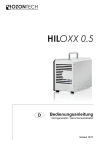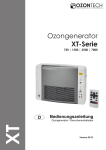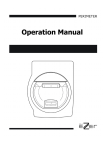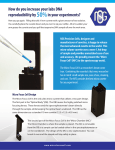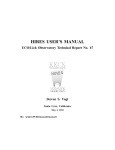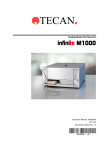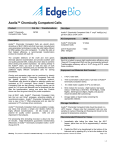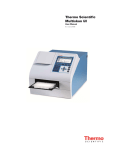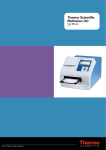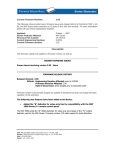Download Data Sheet Optical Transmission Meter
Transcript
Transmission Meter for methylene blue test solution Description 1. Background The German standard DIN 52980 “Photo-catalytic activity of surfaces – Determination of the photocatalytic activity by degradation of methylene blue” asks for a measurement of the optical absorbance in order to quantitatively determine the degradation rate. Due to an absorption band of methylene blue in the range of 664 nm the measurement shall be performed at a wavelength of 664 ± 5 nm. The transmission meter of MRC is designed to conduct this measurement. Transmission meter user manual version 2 – 25.04.2013 page 1 of 8 2. Brief description The transmission meter comprises a red LED, a calibrated photo-diode, a flexible mounting bracket and the required electronics. The LED emits light at a wavelength of 659 ± 11 nm, i.e. exactly in the absorption band of methylene blue (see figure 1). A decrease of the methylene blue concentration thus leads to an increase of the transmission of the LED light through the solution. This increase is measured by the photo-diode. Figure 1: Emission spectrum of the LED (red) and transmission curve of methylene blue solution (blue). The peak of the LED lies in the absorption band of methylene blue around 664 nm. 3. Mounting bracket LED and photo-diode are integrated into a special mounting bracket which enables a flexible positioning at different sample containers. Figure 2: Mounting bracket in horizontal (left) and vertical (right) orientation 3.1. Option with flow cell As an option we offer a modified version of the mounting bracket which can be connected to a flow cell. The optoelectronic components are the same, but it is mechanically optimized for the small dimensions of the flow cell. Transmission meter user manual version 2 – 25.04.2013 page 2 of 8 Figure 3: Combination of mounting bracket with flow cell 4. Electronics Figure 4 shows the front side of the electronic box with different elements. At the bottom there are connectors for the cables of the LED and the photo-diode as well as for the transmission signal output. The signal can be read out by any multimeter. Alternatively, it can be recorded on a data logger. Two potentiometers at the top can be used to adjust the LED intensity and the amplification of the photodiode, respectively. The function of the saturation indicator is described in section 4.1. The on/off switch and the connection for the power cable are on the rear side of the electronic box. Figure 4: Electronics of the transmission meter We have implemented a couple of features in order to enable stable measurements: • Current stabilization of the LED (compensation of power variations due to temperature drift) • Electronic chopper for offset suppression against room and ambient light • Electronic noise suppression • Coloured glass filter (Schott OG530) for suppression of ambient light Transmission meter user manual version 2 – 25.04.2013 page 3 of 8 4.1. Adjustment of the optimal signal range The LED intensity and the amplification of the photo-diode should be adjusted in that way, that the signal range for unbleached and maximally bleached solution is fully utilized. For this purpose a preparation measurement with distilled water in the sample container should be performed under the expected ambient conditions. Hereby, the adjustment can be carried out in the following way: • • LED intensity: The electronics can be adjusted to the maximum expected light intensities with distilled water in the sample container. You should increase the intensity with the potentiometer until the LED indicator marked with “Saturation” is not just yet shining. This process does not depend on the chosen amplification. Amplification of photo-diode: In order to adjust the amplification you should connect the output signal to a multimeter. Still, you should have distilled water in the sample container. By turning the potentiometer for the amplification you should reach a voltage of less than 5V. 5V is exactly the saturation voltage of the amplifier. We recommend a value of about 4.5 V. If you have a vertical orientation of the mounting bracket we recommend to place the photo-diode in the upper position since it will catch less interfering background light in this position. In case of a bright environment you can reduce the saturation limit. But this will limit the dynamic range (signal-to-noise) of the photo-diode. 4.2. Option with fixed adjustment for the flow cell As an option we offer an electronic control where the LED intensity and the amplification of the photodiode are already adjusted to fixed values. This option is usually chosen in combination with a flow cell. It has the big advantage that – after a single calibration – you have a defined correlation between the signal output voltage and the methylene blue concentration. The internal adjustments of the LED intensity and the amplification of the photo-diode are optimized for transmission values which occur with typical methylene blue concentrations according to the German standard DIN 52980. Figure 5 shows a photo of the respective electronic box. Figure 5: Electronic box of the transmission meter with fixed adjustments Transmission meter user manual version 2 – 25.04.2013 page 4 of 8 5. System for continuous measurements An insufficient mixing of the test solution can affect the measurement results e.g. if solution close to the sample's surface is already bleached but the overall solution shows a different average concentration and therefore another absorbance. If the transmission is measured at a wrong position you will get incorrect values then. The German standard therefore suggests that the solution is stirred in periodic time intervals. As an option we offer a set of components which make it easier to determine the concentration according to the standard. The “stirring” of the test solution was carried out by recirculating it in a closed loop. Figure 6 schematically shows the respective setup. Peristaltic pump Flow cell Figure 6: Setup with sample container, flow cell and peristaltic pump for continuous measurements of the methylene blue concentration 5.1. Flow cell The central element of this setup is a flow cell with a defined optical depth. Since the liquid column which is relevant for the transmission measurement has a constant thickness, this setup has the advantage that it enables absolute concentration measurements after a one-time calibration of the mounting bracket. If the adjustment of the LED intensity and the photo-diode is carried out once there is no need for additional modifications. In the electronics described in section 4.2 this adjustment is already made. Notes: • • If you connect the tubes to the flow cell please take care for a stable connection. Please avoid any dye in the flow cell support since it would distort the measurement. It is hard to clean the support. Thus, if any dye gets into the support, please contact the manufacturer. In order to fix the tubes to the flow cell we include appropriate hose clips in the delivery. 5.2. Peristaltic pump A peristaltic pump is used to recirculate the test solution (see figure 7). The flow rate is adjusted to a value which – according to our experience– enables a sufficient mixing of test solution in the sample container. Transmission meter user manual version 2 – 25.04.2013 page 5 of 8 Figure 7: Peristaltic pump at housing. The flow cell with the connected tubes is mounted a the right side. The peristaltic pump is integrated in a UV-stable aluminium housing so that it can be used directly in the illumination chamber. There are screws at the housing to mount the flow cell. The pump is powered by a wall power supply. Notes: (1) Especially when you replace the tubes it can happen that air is getting into them. Please make sure that air is not accumulating at the transmission window of the flow cell where it would distort the measurement. The elimination of air is easier if you turn the flow cell in an upright position as shown in figure 3. If an air bubble is fixed to the transmission window (i.e. in a stream burble), you can try to resolve and remove it by snapping with your finger and actively moving the tubes. (2) Please take care to keep the transmission window in a clean state. (3) If the flow cell is wetted with methylene blue or other dyes you should recirculate it with distilled water in order to avoid a dry coating. 5.3. Sample container Figure 8 shows the example of a sample container which can be integrated into a closed loop. For an easy performance of a continuous measurement we have equipped the container (diameter: 80 mm, height: 45 mm) with a top frame which carries tube connectors and a UV transmitting glass cover. The container accepts samples with an area of 50x50 mm². Note: The absorption of the chosen UV glass cover at a wavelength of 365 nm is about 11%. The test solution in the container can be circulated through a flow cell by means of a peristaltic pump to which the bracket for the transmission measurement can be connected. We have selected tubes which do not absorb methylene blue and which are stable against UV illumination. Transmission meter user manual version 2 – 25.04.2013 page 6 of 8 Figure 8: Sample container with tube connectors and glass cover 6. Technical data (subject to change) Light source: Kingbright L-1513SRC-C, Spectrum is shown figure 1 Photo-diode: Centronic OSD15_5T Wavelength range: 400 – 1.050 nm Sensitive area: 15 mm² Sensitivity: 0,21 A/W Dark current: 3 nA Figure 9: Left: Output signal of the photo-diode vs. intensity of a reference signal Right: Spectral sensitivity of the photo-diode Transmission meter user manual version 2 – 25.04.2013 page 7 of 8 6.1. Accessories Flow cell: Peristaltic pump: Tube: 7. Hellma Analytics, 10 mm, 178.010-OS Z.8 Gemke LP 60, Rotational speed: 30 TPM, Flow rate ~ 14ml/min at pump: Silicone else: PVC / Thickness: 2.8x4.2 Appendix: Calibration of voltages vs. methylene blue concentration The following figure shows voltages for different methylene blue concentrations recorded with the transmission meter and a flow cell: Figure 10: Typical calibration curve: Voltages vs. methylene blue concentration At the low right of the diagram the formula for the voltages and the dye concentration is displayed as a result from fitting. The formula can be used to calculate the concentrations from measured voltages. Notes: • The calibration strongly affects the resulting photo-catalytic activity. Coating of dyes or air bubbles in the flow cell, dirt or debris and further aspects have an effect on the calibration. That is why the calibration should be checked from time to time. • The measurement of voltages at a couple of known methylene blue concentrations and comparison with the original calibration can give a good indication for the reliability of a calibration. • Each calibration will lead to a new fitting curve and formula. Transmission meter user manual version 2 – 25.04.2013 page 8 of 8








